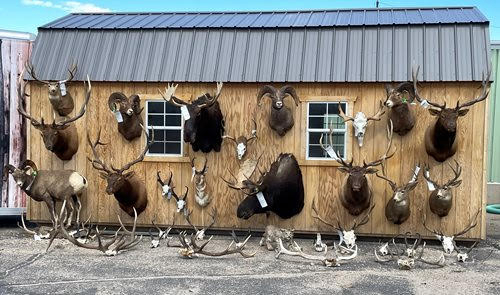To Tip the Impossible Tom – Advice for Tricky Turkey Tribulations By Todd Amenrud
 Natural turkey biology can make turkey hunting seem difficult. Then throw in the mistakes we make and the sour hands Mother Nature can deal every so often and harvesting a springtime tom can seem near impossible. Persistence, patience, and hunter’s savvy are valuable qualities when it comes to hunting turkeys, and save heart, there are ways to combat our errors, Mother Nature and even a stuck-up tom.
Natural turkey biology can make turkey hunting seem difficult. Then throw in the mistakes we make and the sour hands Mother Nature can deal every so often and harvesting a springtime tom can seem near impossible. Persistence, patience, and hunter’s savvy are valuable qualities when it comes to hunting turkeys, and save heart, there are ways to combat our errors, Mother Nature and even a stuck-up tom.
It’s good to be the king
It’s dark when you sneak into your morning set up and you’re waiting for the horizon to brighten. You commence calling with a few soft tree-yelps and he hammers your offering. Then you hear live hens beginning to sound off around you. I don’t care if you were born with a diaphragm call in your mouth – it’s difficult to compete against live hens. If you’ve done your scouting, the birds may have a pattern from day to day. Try to set up in the direction you believe they’ll travel once they fly down.
If all you have is a good guess there are several tactics you might try. One, is to sound like the “hottest,” sexiest hen in the woods. Give him your best stuff. When turkeys want to get together with other turkeys they make noise. You’ve heard the story about the “squeaky wheel.” Often I’ll use two calls at once, a diaphragm and either a slate or box call. Try to fire-up the gobbler until he HAS TO come to you.
If the gobblers are already with the hens and you cannot change locations your best tactic will probably be to pick out the most vocal hen in the flock and imitate whatever she does. Mimic her every sound and call over the top of her vocalizations if you can. Make her curious or make her mad. This can work to call the entire flock your way, or irritate the dominate hen so she’s compelled to investigate. I may suggest using two calls at once or several hunters all calling.
If either of these tactics fails there are two additional things you can attempt. You can try to wait him out. Hopefully he’ll finish with the hens and be back to check on you. It’s amazing the way they can pinpoint and remember exactly where sounds were coming from. But if you’re impatient, as I often am, you’ll have to go after him. DON’T go directly to him. Always back off a bit, and try to circle to head him off. If you have no luck doing this you can go back to your original setup. More often than I care to admit I’ve returned to the original spot and right where I had my decoys is a fanned-out “strutter.”
We’ve been disconnected
If a gobbler stops answering your calls, several things may have happened. Staying right where you are is probably the best advice. He may be silently on his way to you or he may have found real hens (referred to as “henned-up”). Once they finish with the hens, they often remember where your yelps were coming from earlier. If you think you’re in a good spot you can stick it out for an hour or more. Aside from the tom you originally set-up on, you’re giving other gobblers a chance to get to you.
Much of the decision should depend upon the size of the property. On a small property I’d almost certainly stay put so as not to bump the birds across a fence where I don’t have permission. However, on a large property I may choose to find a more responsive bird.
It doesn’t matter what you say
The toms were “tight-lipped” – you hear this excuse all the time. It could be the weather or it could be specific times during the breeding season. Sometimes rain or other bad weather will make it seem like the gobblers have been stifled. Also, each spring there is usually a lull in the gobbling action during the actual peak of breeding activity. The most electrified gobbling takes place before breeding starts, and commences hot and heavy again when the hens are nesting. You can call birds to you in bad weather and during this lull – it’s definitely tougher, but not an excuse.
Scouting is an important part of hunting anything, but will especially pay dividends if this happens. Knowing “for certain that the bird(s) is/are there” is the main thing. Just because they’re silent doesn’t mean they’re not going to react. I’ve had gobblers approach in full-strut for several hundred yards and never utter a peep. Keep alert and don’t move! They have your location pin-pointed. Without you being able to hear them, they have the advantage in this situation.
Secret Agent Tom
Gathering intelligence on your quarry and the terrain is essential. Turkeys will have yearly patterns, seasonal patterns and daily patterns – it’s really those daily movements that are important to learn. You want to discover the travel patterns of the local flocks. When you’re scouting watch for the heavy concentrations of turkey sign. Rather than trying to call turkeys into places they don’t normally frequent, if you set up in a spot they commonly go to or travel through it’s much easier to get them to come to the call – it’s just common sense. If you don’t put some time in before the hunt you may be fumbling around “blind.”
At the very least you should study Google Maps, an aerial photo or topographical map before your hunt. Learn to identify funnels and natural obstructions. Understandably, every situation is different. You must play your particular type of terrain and learn to use it to your advantage. Use those “hang-ups” like creeks, blow-downs, and fences to help funnel turkeys in a particular direction. Once you locate a gobbler try to imagine what may be in-between you and the bird(s). If you think there’s the slightest chance the gobbler might find difficulties reaching you, move to a spot that’s easier for them to access.
Your “mix tape” fails
Sometimes the tom seems like he doesn’t pay attention to you, or maybe you think he spooks from your calling. Along with increased turkey populations, comes increased turkey hunter numbers as well. In areas that get a little pressure you’re bound to run up against what some label a “call-shy bird.” I don’t think turkeys actually get “call-shy” I think they get “stupid hunter-shy.” There may have been ten other “bubbas” calling to this bird before you got there. No two situations are the same, but there are a couple things you might try.
Your best bet is trying to pattern the bird. Learn his roost site(s), preferred strutting zones and favorite travel routes. Then simply set-up where you think he’ll travel. Using simple, soft, passive calling or non-vocal turkey noises (like wing flaps and scratching in the leaves) will usually work best on one of these birds. I’ve watched a fair number of gobblers fall to nothing but noises made from a turkey wing. Just imagine the sounds that a content hen scratching in the dried leaves or grass for acorns or insects.
If you hit the breeding season too early or too late, gobblers don’t come to hen calls like they do when things are happening hot and heavy. In this case you may be better off trying to sound like other gobblers, especially if you hit it early. Kind of like a bachelor group of bucks, gobblers will hang out together too. In fact, for most of the year this is the case. Early, before the first signs of breeding and after you’re sure the hens are nesting, you may be better off impersonating this all-male social scenario.
Not enough sense to come in out of the rain!
Use common sense when battling adverse weather. Where do you want to go in a bad wind or rain? Most animals search out protection from the elements – probably down the hill towards the bottom of the drainage or on the lee-side of thick cover, somewhere protected from the elements. A turkey will search out protection also. In flat areas where you don’t have hills to play, this detail is still important. In severe winds look for turkeys to be on the lee-side of thick timber, or wherever they can get out of the elements.
A possible cure for many turkey hunting dilemmas
Decoys can be the possible cure-all for many turkey hunting quandaries. You need at least one hen decoy, but I believe a strutting (or half-strut) male decoy is the one that really draws a response. There are many on the market, some allow you to stick your own full-strut fan into the decoy. Decoys draw the attention off of you, they give the birds a reason to come closer and when needed, they can be used for a yardage reference.
To me the true essence of turkey hunting is the “call-up” and the trickery in your set-up. I want to create a set-up that seems so real and enticing to a gobbler that he has to come to interact. At times during the season toms just don’t react to hen calls well. But rather than “bush-whack” a bird, I would rather go home with an unused tag. I enjoy the call-up no matter what means you use to harvest the bird. In fact, I enjoy calling for other people as much as when I hunt myself. If you hunt turkeys long enough you’ll eventually wind up having to deal with all of these scenarios.
Would you like to learn more about improving your hunting and get discounts on the products you need? Learn from the experts by joining the new Mossy Oak GameKeepers Club at www.gamekeepersclub.com. Or call 662-495-9292.






